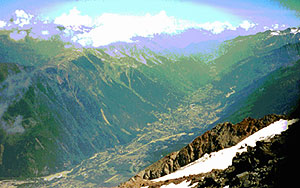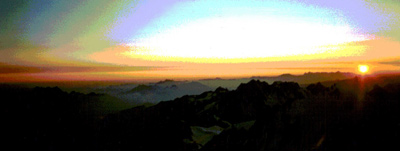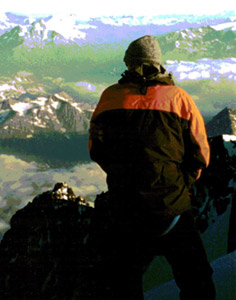Mont Blanc:
“OK, if I can get my waterproofs on without throwing up, then I’ll try for the summit.”
We are at the Gouter Hut (3,800 meters above sea level) en route to the highest point of Western Europe, Mont Blanc (4,810 m). The previous day, Dave, my 30-year-old business partner and marathon runner, and I had been marched Napoleon-style halfway up the mountain. We were now suffering quite badly from altitude sickness, hence the severe headaches and nausea, and had reached a decision-making point.We had essentially gone from sea level to 3,800m in six hours. We assumed our guide would ensure that we were properly acclimatized. In hindsight, we had clearly relied on him far too much.

The previous day had certainly been eventful. We had set off from Chamonix and arrived at the base of the climb after taking a cable car (or “telepherique”) from Les Houches to Bellevue and a tram to Nid d'Aigle (2386m). The Gouter route had been chosen because of its lower risk of avalanche than other routes. However, it held a nasty obstacle in the guise of “The Grand Couloir,” an almost vertical corridor that ran down the mountain and had to be crossed to continue the route.
I had seen a description of the Couloir that likened it to “a bowling alley, except you are the pins, and the balls are gigantic boulders dislodged by melting ice that come hurtling down the mountain at you.” In our panic to get across (mainly due to the panic of our guide who seemed certain that he would be hit!), Dave’s crampon came off. Thankfully, the Bowling Gods spared us and we made it safely across.
That evening at the Gouter Hut, I noticed a woman peering at and pointing at me from across the room as I tried to force down yet another liter of water to reduce the effects of altitude. She was obviously concerned, and it must have been obvious to her that both Dave and I should immediately descend to a lower altitude if we were to avoid more serious illness. Unfortunately, it was less obvious to us, as inexperienced Alpinists, so we decided to stick it out.
At 3am, after an uncomfortable night spent in a room of more than 30 snoring men, and with less than two feet of space to myself, it was decision-making time. Dave, still suffering a cocktail of Trans-Atlantic jet lag and altitude sickness, made the right decision in hindsight and decided to forego the summit attempt. I somehow managed to get my waterproofs on without losing my breakfast. Assuming that I would get no further than two minutes from the hut and then be forced to return with altitude sickness, I decided to give it a go.
Commencing the summit climb, the scene that met my already dizzy eyes was startling. All around was a dreamlike blanket of pure whiteness, covered by a dark blue ceiling, pinpricked by twinkling stars. The moonlit peaks in the distance seemed close enough to touch through the crystal-clear air. Up ahead, I could see groups of lights snaking their way higher and higher up the mountain. These were the head torches of fellow climbers covering the steps that I would soon follow.
Whether due to the astonishing views, or the fact that my body, now moving, was adapting to the altitude, I started to feel less nauseous. In fact, as the hours passed, I began to feel increasingly better. The rhythm of switching ice-axe to the inside hand at each turn and avoiding standing on the rope with crampons, was making me feel better with each step. We were now two hours into the climb and approaching the Col du Dome (4,240m), just before the final ridge to the summit. It was starting to become brighter now, and suddenly, as we reached the flatter slopes of the Col…
Bang! The world suddenly turned gold. The sunrise over the eastern peaks ricocheted and spread over the entire landscape, turning the grey-white of dawn to a shimmering gold. Long shadows were cast west by the climbers, pointing toward similarly astonishing views beneath a full moon still high in the sky.
 I was woken from my trance by the guide, impatiently urging me to continue. He was cold. He had already been up this mountain and had seen this view countless times before. For him, the goal was to get people up and down this mountain as quickly as possible and to get it over with. Any enjoyment along the way was superfluous. I felt it was time he got a new job.
I was woken from my trance by the guide, impatiently urging me to continue. He was cold. He had already been up this mountain and had seen this view countless times before. For him, the goal was to get people up and down this mountain as quickly as possible and to get it over with. Any enjoyment along the way was superfluous. I felt it was time he got a new job.
I turned southeast toward our remaining route along the Bosses Ridge. It looked as frightening as I had previously read. The ridge is a narrow razorback with long sheer drops on either side, and climbers scramble past each other on ascent and descent. Many climbers are infamous for their lack of manners and concern for their fellow mountaineers in such a dangerous place, making it all the more hazardous. Someone else clearly felt the same as I passed newly formed patches of vomit, outlined starkly against the snow.

Looking sideways off the ridge into yawning mile-deep drops on one side to France and the other side to Italy was very unnerving. I decided to focus on one step at a time and just look straight ahead. Passing the descending climbers was distressing at first, but soon became second nature. Near the top, I was beginning to feel more comfortable on the ridge, and finally, at last I had reached the summit to see.
There, on the highest point of Western Europe, a man was urinating off the side. A surreal sight for me; Europe’s most scenic restroom for him! I didn’t have time to establish whether this was a statement he was making or just the call of nature, for once again, the guide was urging me off the mountaintop. Perhaps he could see his TV from where we stood.
Although I only stood for less than a minute on the summit, the views (with the exception of our urinating friend, of course) were nonetheless fantastic. As my first experience of Alpine climbing on any summit over 4,000m, it was an experience that I will never forget, no matter how hard the guide worked to ruin it. Let’s hope he has a new job now!
